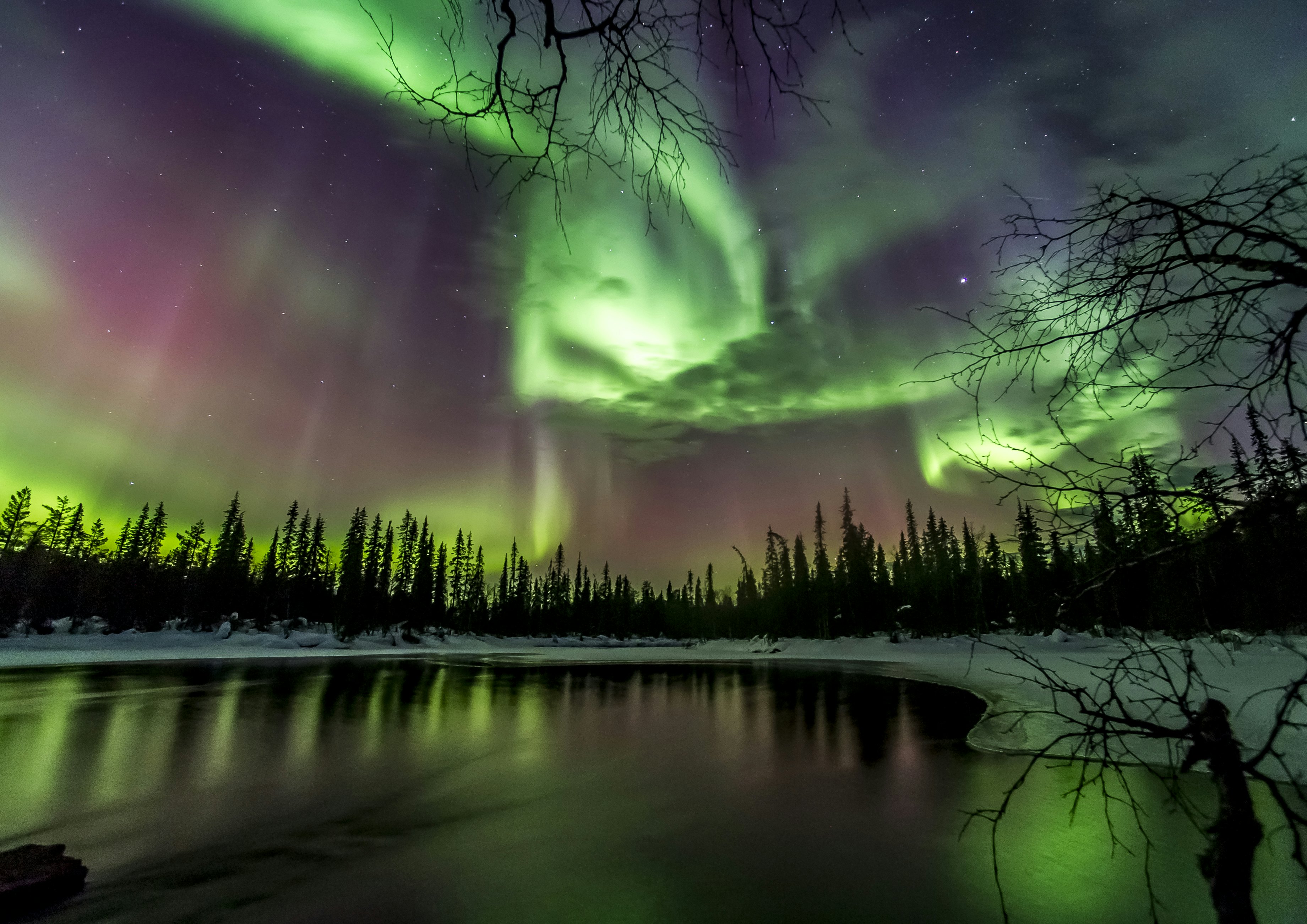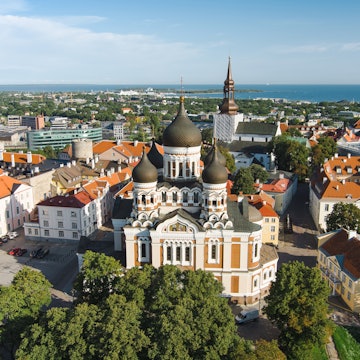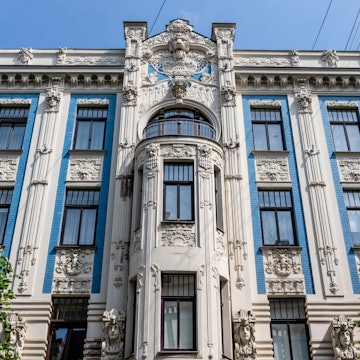
How to visit Finland on a budget (the only guide you’ll ever need)

Apr 26, 2022 • 10 min read

Take in a spectacular view of the northern lights in Finland © Anton Petrus / Getty Images
Let’s face it: Finland is expensive – unless you happen to be coming from Sweden or Norway, that is. But with some careful budgeting and clever planning, you can have an incredible trip that doesn’t cost a fortune. The good news is that many of the things that attract travelers to Finland in the first place are free or cost very little: From foraging walks to Northern Lights shows, chilly dips in the Baltic to lakefront saunas.
From where to stay and eat, to getting around and sightseeing, here we give the inside scoop on how to see Finland without breaking the bank.

Flying is the cheapest way to get to Finland
Flying is overall the cheapest, easiest way to reach Finland, and there are plenty of low-cost options, especially if you arrive in Helsinki, which has direct flights to Europe, North America and Asia. Flights with European budget airlines like Ryanair and easyJet are often a steal in the low and shoulder seasons, especially if you aren’t fussy about specific days and times. And it’s also possible to snap up deals with bigger airlines like Finnair, Norwegian and Scandinavian Airlines (SAS). Look out for their economy deals and travel with minimal luggage. The more flexible you are, the greater the chance you have of grabbing a bargain.
Consider flying into somewhere other than Helsinki
Helsinki often seems the obvious choice, but it might be worth considering flying to another airport if you’re heading straight off or taking an internal flight. If Lapland is your goal, you can fly direct to Rovaniemi instead with a number of European airlines, including budget ones like Ryanair and easyJet, though often only during the winter season (November to March). Ryanair also operates a direct flight from London Stansted to Tampere, a handy gateway for the great forest-rimmed lakes of Finnish Lakeland.
Travel in the shoulder season to save money
Everyone raves about July being the best month to visit Finland, but you’ll dodge the crowds and save plenty by avoiding school holidays and visiting in the shoulder season instead. With everything in blossom, the rain easing off and warmer, lighter days on the horizon, May can be glorious on the Baltic coast (try the Åland islands for white-sand beaches and cycling), in the Finnish Lakeland and in cities like Helsinki.
Early June – before the madness of midsummer hits – is a good bet too. Or come in September for an inexpensive city break, country escape or hike in one of Finland’s national parks before the darker, colder days of winter creep in. The flipside? Some accommodation, sights and restaurants only open during the peak summer months of July and August. But if you don’t mind things quieter, shoulder seasons are great for economizing.
You can visit Lapland on a budget – if you do the work yourself
It’s the number one must-do on every child’s wishlist, but a trip to see Santa in the frozen wonderland of Lapland can make a massive dent in your wallet – especially if you go for an expensive package. All the fun winter sports you come to the Arctic to try – from snowmobiling to skiing and dogsledding – come with a price tag.
However, go it alone (organizing your own flights and transport and simple lodgings) and it can be doable on a budget. The trick is to avoid the Christmas rush and school holidays. Come in November, January or March when rates dip and you’ll still find plenty of festive sparkle, snow, reindeer and the big jolly dude in his grotto.
Few travelers consider the Arctic in fall, but September in Lapland is beautiful for the ruska (autumn foliage). The fells are a riot of russets and crimsons and the beech forests glow gold. If you want to glimpse the Northern Lights on a budget, try autumn or spring instead of winter, when the odds are actually better and accommodation is cheaper.
Stay in a hostel (and book a dorm room)
If you’re traveling alone, hostels tend to be the best value. Figure on paying around €40 ($44) for a dorm bed. What the hostels sacrifice in style, they make up for in comfort and facilities – most have kitchens (handy for whipping up a quick snack or meal to save on dining out), shared lounges and, if you’re in luck, saunas.
The Finnish Youth Hostel Association (SRM) runs a network of around 50 hostels, with everything from contemporary city digs to country villas on wooded lakeshores. They are affiliated with Hostelling International (HI), so it’s worth becoming a member for a 10% discount.
Or simply sleep in the wild
In the wilder reaches of the country, there are some excellent campgrounds. And if you don’t fancy sleeping under canvas, many offer cozy little cabins for as little as €40 ($44) a night. If you’re striking out on foot into one of the national parks in the remote north or east of the country, even better: You can stay the night in one of Finland’s free wilderness huts for a proper at-one-with-nature experience. Off grid and as basic as can be, these little log cabins are the backcountry dream.
Jokamiehenoikeus (everyman’s right) is music to the ears of outdoor lovers on a budget. The freedom to roam means you can pitch your tent pretty much wherever you fancy, while respecting the privacy of others and the landscape, naturally. If you go down the wild camping route, a few simple rules of thumb apply: Camp high, camp remote, stay only a night or two and leave no trace. You’ll even find lake beaches that are aimed at the wild camper, with toilets, barbecue areas and swimming spots.
Rent your own digs if you’re traveling in a large group
If you’re with family or friends, you might find it works out cheaper (and more fun) to rent your own room or holiday home, either through Airbnb or the Finnish network Lomarengas. The latter has a cracking selection of cottages all over the country – from Lapland log chalets to lakefront cottages with their own beach, rowboat and sauna. The cost breaks down to be quite reasonable if there’s a group of you.
Book a hotel at the weekend or in summer to save money
Hotels in Finland are often geared firmly towards business travelers. Contrary to what you might expect, rates actually plummet by 40% or so at weekends and during the July summer holidays, making this a great time to snap up a deal in fancier places.
Get around on the bus
Punctual, inexpensive and rarely full, Finland’s long-distance buses cover a much bigger network than the trains and are a great way to get around if you don’t feel like renting your own wheels. They are by far and away the cheapest way to travel from city to city. Departures from major towns are frequent, but less so at weekends, so check your timing. Slower vakiovuoro (regular) services are cheaper than pikavuoro (express) buses. For routes, timetables and tickets, visit Matkahuolto.
Onnibus operates budget intercity routes in double-decker buses. Most start in Helsinki and can be considerably cheaper than standard fares if booked well in advance.

Or if you need a car, book ahead
If you’re heading into the epic wilderness of the north and east of the country, where all signs of civilization fizzle out and you are alone with the forest and lakes and reindeer, realistically you are going to need a car. Book in advance for the best deals. Day rates can be astronomical so it works out cheaper to hire a car for an entire weekend or week. Try a cost comparison site like Kayak. Otherwise, apps like Carpool Finland and Kyydit are great if you’re willing to rideshare.
Eat a big breakfast and lunch
Finns are big on breakfast and most hotels ( even hostels, for an extra cost) serve a generous buffet, with plenty of coffee, porridge and fruits, dense rye bread, eggs and cold cuts. Fill up properly to fuel an entire morning of activities.
It’s much cheaper to eat out at lunchtime than in the evening in Finland. Look out for cafes and restaurants serving all-you-can-eat buffets for between €10 ($11) and €15 ($16.50), where you can load up on salads, soups and day specials. And watch what you drink. Alcohol quickly notches up on the bill, with a single beer costing around €6 ($6.60). Thankfully tap water here is a pleasure to drink.
If you have access to a shared kitchen or camping stove, you can buy supplies for picnics and basic meals at grocery stores, bakeries or, even better, at the kauppahalli (covered market hall). The ones in Helsinki, Tampere and Turku are in gorgeous art nouveau buildings. Finland’s markets are also great for grazing, with stalls and cafes dishing out light meals and snacks from kimchi to gourmet rye-bread sandwiches.

Forage for your supper
Finland is a forager’s dream and everyman’s right means you can pick freely providing it’s for your own consumption. Come in summer and you can feast on luscious berries, from wild strawberries, lingonberries, raspberries and, up in the Arctic, the creamy-sweet, amber-hued cloudberries the Finns are so crazy about. Mushrooms pop up from late August to October, sending the Finns diving into the woods, armed with baskets, to find chanterelles and penny buns. Cobbling together a meal with what you’ve found for free in the wild is really quite special.

Get out into nature
There’s no need to spend a fortune in Finland because, as any local will tell you, nature gives you all the best things for free. One way to see Finland on a tight budget is to go off grid and back to nature. Embrace the elements in true Finnish style on long hikes to forests and fells in one of the country’s national parks. Wild camp and swim in the river or sea. Cook over a campfire as the midnight sun shines or gaze up to Arctic skies in winter for the best free show on earth: the Northern Lights.
Save money on sights and attractions
Saving money on the city sights involves a bit of cunning planning. If you’re up for seeing the capital, the Helsinki Card is a must. Valid for 24, 48 or 72 hours, the pass covers all the big-hitter sights and attractions and public transport, and gets you discounts on shops and restaurants.
Helsinki’s museums often have one day a week or month when there is reduced or free entry. The Design Museum, for instance, is free on the last Tuesday of the month between 4pm and 8pm, and Kunsthalle Helsinki is free on the first Wednesday of the month between 6pm and 8pm. See the MyHelsinki website for a comprehensive list. In Tampere, many museums are free on Fridays from 3pm to 6pm.
And if you want to save on sauna entry, swing over to Sompasauna. Run by a group of volunteers, this wood-burning, self-service sauna, just east of the center, is right by the sea and there’s an open grill where you can cook.
One way of getting a handle on Finland’s cities is to hook onto a free guided walking tour. Eco-friendly Green Cap Tours runs these in a number of locations in Finland, including Helsinki, Rovaniemi, Levi and Turku.
Daily costs
Dorm bed in a hostel: €25-35 ($27.50-38.50)
Basic room for two: €80-100 ($88-110)
Holiday cottage: €80-150 ($88-166)
Museum entry: €10-14 ($11-15)
Car hire: €25-50 ($28-55)
Public transport ticket: €2.80 ($3)
Bike hire: €10-20 ($11-22)
Kayak rental: €30-60 ($33-66)
Two-hour husky sled ride: €90–140 ($99-155)
Coffee: €3-6 ($3.30-6.60)
Sandwich: €5-7 ($5.50-7.70)
Piece of cake: €6-8 ($6.60-8.80)
Lunch buffet: €10-15 ($11-16.50)
Main course in a restaurant: €18-30
Dinner for two: €60-100 ($66-110)
Beer at the bar: €6-9 ($6.60-9.90)















